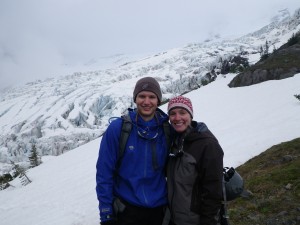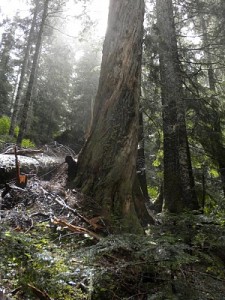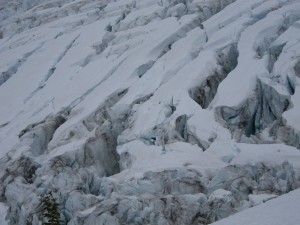 We left downtown Seattle at 5:30 am to drive to Glacier Ranger Station at the base of Mount Baker. During the entire two hour drive there was a steady cold rain. Under a small overhang outside of the station we met the rest of our group, Dave and J.R., also software engineers, Jenny, Everett, and Forest, our guide. We dumped our packs and did a quick gear check. We had our first worry when Forest mentioned to Jenny it was rare he had to tell someone they had not brought enough stuff. Steven graciously, after several moments of hesitation, offered his brand new Patagonia Capilene 3, top of the line shirt to our egregiously under packed group mate. Forest then instructed us on the mountaineering style of packing a pack which is different than backpacking. With our packs full, and brief introductions out the way, we carpooled down to the trail head. We set off down the Heliotrope trail in our plastic Koflach mountaineering boots and knee high gators with our ice axes, crampons, zero degree bags, pounds of food and supplies packed away. The hike was not easy. There was a steady and sometimes steep incline the
We left downtown Seattle at 5:30 am to drive to Glacier Ranger Station at the base of Mount Baker. During the entire two hour drive there was a steady cold rain. Under a small overhang outside of the station we met the rest of our group, Dave and J.R., also software engineers, Jenny, Everett, and Forest, our guide. We dumped our packs and did a quick gear check. We had our first worry when Forest mentioned to Jenny it was rare he had to tell someone they had not brought enough stuff. Steven graciously, after several moments of hesitation, offered his brand new Patagonia Capilene 3, top of the line shirt to our egregiously under packed group mate. Forest then instructed us on the mountaineering style of packing a pack which is different than backpacking. With our packs full, and brief introductions out the way, we carpooled down to the trail head. We set off down the Heliotrope trail in our plastic Koflach mountaineering boots and knee high gators with our ice axes, crampons, zero degree bags, pounds of food and supplies packed away. The hike was not easy. There was a steady and sometimes steep incline the  entire way. There was a challenging creek crossing that promptly soaked our feet. The moment before that crossing would be the last time my feet would be dry for the rest of the trip. It was not long after the creek that we started crossing snow fields. The pleasant smell of the Douglas firs and the absolutely lush environment was gorgeous and made the grueling hike bearable. The misting rain continued through the several hour hike and validated the claim that Mount Baker gets more precipitation than anywhere else in the United States. We reached our first campsite Mirkwood. We put down our heavy packs and Jenny reached in her pack and pulled out a completely empty Platypus water bottle. As she took the wrapper off Forest asked if that meant she hadn’t carried up any water, and asked her when the last time she had had any water. 5 am. Steven handed her an extra Nalgene and told her to start chugging. Mirkwood is an ancient growth rainforest with moss growing on and hanging from the trees. The site is on a moraine, an area of rock and debris pushed up the surface by the Coleman Glacier. We decided on tent groups and Jenny was placed in a group with Steven and I. We set up camp in the rain and hiked onto the glacier. Once on the glacier, Forest taught us how to walk on snow with our mountaineering boots to maximize our efficiency. We learned uphill, downhill, side foot, crossover, duck walk and plunge step. What was seemingly easy was actually awkward. From the glacier there was an amazing view of hundreds of crevasses.
entire way. There was a challenging creek crossing that promptly soaked our feet. The moment before that crossing would be the last time my feet would be dry for the rest of the trip. It was not long after the creek that we started crossing snow fields. The pleasant smell of the Douglas firs and the absolutely lush environment was gorgeous and made the grueling hike bearable. The misting rain continued through the several hour hike and validated the claim that Mount Baker gets more precipitation than anywhere else in the United States. We reached our first campsite Mirkwood. We put down our heavy packs and Jenny reached in her pack and pulled out a completely empty Platypus water bottle. As she took the wrapper off Forest asked if that meant she hadn’t carried up any water, and asked her when the last time she had had any water. 5 am. Steven handed her an extra Nalgene and told her to start chugging. Mirkwood is an ancient growth rainforest with moss growing on and hanging from the trees. The site is on a moraine, an area of rock and debris pushed up the surface by the Coleman Glacier. We decided on tent groups and Jenny was placed in a group with Steven and I. We set up camp in the rain and hiked onto the glacier. Once on the glacier, Forest taught us how to walk on snow with our mountaineering boots to maximize our efficiency. We learned uphill, downhill, side foot, crossover, duck walk and plunge step. What was seemingly easy was actually awkward. From the glacier there was an amazing view of hundreds of crevasses. Crevasses are the cracks that form in the glacier that can be hundreds of feet deep. They also pose the greatest threat to climbers as they are not always visible because the top can be covered in snow or a thin layer of ice. A major skill of mountaineering is knowing crevasse rescue. The main reason teams are roped together is to aid in rescue. On the opposite side of the crevasse field was a view of Mirkwood. From the glacier the moraine appears as a cliff with the edges exposed and crumbly. Every so often a loud crash could be heard with rocks plummeting off the edge. Forest pointed out to us the danger of hiking near the edge of a moraine as they are quite unstable. An aspect of a glacier is that the ice is in motion therefore the glacier has many of the same properties as a river, although it moves much slower. (Glaciology 101). After mastering the art of walking on the snow, we pulled out our ice axes for an explanation of self arrest. Self arrest is the technique of stopping yourself and/or your team from falling down a glacier or into a crevasse. Using the ice ax, you fall to the ground, dig the pick of the ice ax into the snow and ice and dig your feet in the snow. We practiced self arresting while falling forward, backwards, and upside down the mountain. This practice was fun and got us even wetter. We headed back to camp to cook dinner. At this point Forest graciously offered to fill everyone’s water bottles at the nearby creek. Ten minutes of so later he reappeared with a pack full of water bottles and a sheepish expression on his face “So, uh, who has the reaaaally slippery orange Nalgene?” Dave chimed in, “You mean ‘had’ right?” And somewhere in the North Cascades is my dear water bottle from Indiana’s only mountaineering store. At dinnertime Jenny realized that she had no utensils with which to eat. We made hot drinks, something we would do very often on the trip and went to bed after a long day.
Crevasses are the cracks that form in the glacier that can be hundreds of feet deep. They also pose the greatest threat to climbers as they are not always visible because the top can be covered in snow or a thin layer of ice. A major skill of mountaineering is knowing crevasse rescue. The main reason teams are roped together is to aid in rescue. On the opposite side of the crevasse field was a view of Mirkwood. From the glacier the moraine appears as a cliff with the edges exposed and crumbly. Every so often a loud crash could be heard with rocks plummeting off the edge. Forest pointed out to us the danger of hiking near the edge of a moraine as they are quite unstable. An aspect of a glacier is that the ice is in motion therefore the glacier has many of the same properties as a river, although it moves much slower. (Glaciology 101). After mastering the art of walking on the snow, we pulled out our ice axes for an explanation of self arrest. Self arrest is the technique of stopping yourself and/or your team from falling down a glacier or into a crevasse. Using the ice ax, you fall to the ground, dig the pick of the ice ax into the snow and ice and dig your feet in the snow. We practiced self arresting while falling forward, backwards, and upside down the mountain. This practice was fun and got us even wetter. We headed back to camp to cook dinner. At this point Forest graciously offered to fill everyone’s water bottles at the nearby creek. Ten minutes of so later he reappeared with a pack full of water bottles and a sheepish expression on his face “So, uh, who has the reaaaally slippery orange Nalgene?” Dave chimed in, “You mean ‘had’ right?” And somewhere in the North Cascades is my dear water bottle from Indiana’s only mountaineering store. At dinnertime Jenny realized that she had no utensils with which to eat. We made hot drinks, something we would do very often on the trip and went to bed after a long day.
Signing off,
Soaky Socks Lib and Grey Jumpsuit Steven
The Travels of JollyLibGiant

sounds awesome! (minus the cold, the grueling hike, the snow, and the ice).